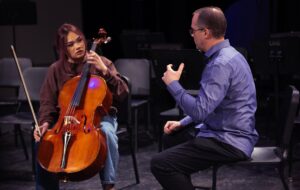You Don’t Need to Have It All Together
Students don’t need a perfect teacher — they need a present one, so just keep showing up.
I was cleaning my office while answering an email and printing off a score that I hadn’t marked yet. The bell rang, and I heard chairs scraping the floor. Rehearsal hadn’t started, but my students were already watching me.
One student raised an eyebrow and asked, “Mr. Stinson… are you okay?”
I froze, standing in front of a stack of junk, holding a dented mute in one hand and a half empty bag of pretzels in the other. I laughed it off. “Of course, I’m fine. Just … multitasking.”
But the truth? I was fried.
That morning I’d spent 15 minutes trying to find a stapler. My warm-up plan was scribbled on a sticky note. I had three emails flagged “urgent,” a festival on the calendar, and a mental to-do list that kept looping louder than the trumpets in chorale.
I wasn’t okay. But I thought I had to look as if I was.
(Good luck faking this. I’m not sure what gave me away to the student — could it have been all the junk in my hands, stuff all over the room or my thousand-yard stare?)

You Can Be a Mess and Still Be a Great Teacher
There’s this invisible pressure early on — especially in your first three to five years of teaching — that you need to prove yourself. So, you show up polished, show that you’re organized and show that you have a system. In other words, you show that you belong.
If you’re a newer teacher stepping into an established program, multiply that pressure by 10. You feel like you’re not just maintaining a legacy — you’re defending it.
So, we spend energy trying to look the part. I once rewrote our band handbook four times. Not because it was wrong, but because I thought it needed to sound more “official.” I changed fonts, reworded the concert expectations, even added clip art — none of it made me a better teacher.
The problem is that trying to look put together takes real time and energy away from actually being present for your students.
Let’s cut to the present. Some days my desk looks like a brass explosion. I still plan, but I don’t obsess. I still stay late sometimes, but not to polish something no one asked for. When I stopped pretending to be fine all the time, I had more space to actually teach.
And I still have no clue which instrument is home to this random single valve that has been sitting on my desk for three years.

Cut the Right Corners
To be clear: Cutting corners is not the same as slacking off. It’s about being smart with your limited time and energy.
Here are a few corners I’ve learned to cut — without guilt:
- Rehearsal visuals: Your whiteboard doesn’t need four colors of Expo ink. If you get the order right and spell everything mostly correctly, you’re good. (I know at least three people who will feel personally attacked by this. I really enjoy your colorful whiteboards, but I simply cannot handle more than one marker).
- Warmups: A consistent, effective warmup routine beats a brand-new exercise every week. Repetition is not laziness — it’s structure. If you need some variety, consider an A, B and C set.
- Email perfection: Stop rereading every email to a parent like it’s a dissertation. Be clear. Be kind. Be done. I wrote this tip mainly for myself, but if this helps you save some time, great!
- Paper clutter: Pick one drawer to be the “I-can’t-throw-it-out-yet” drawer. It’ll save you hours of over-sorting.
And if someone else’s corner-cutting system works for you? Steal or borrow it without shame. Most of what’s saved my sanity came from another teacher who said, “Here, just do this.”

Students Don’t Need Your Best Performance — They Need Your Real Self
I often say that no one sits around talking about the times that were perfect.
You know what students remember?
- That time you made a mistake and owned it.
- That moment you told them you were tired but excited.
- That morning you said, “We’re changing our plan today because last night didn’t go as planned.”
- That time you stayed calm when everything went off the rails.
They’re not expecting you to be flawless. They’re watching how you react when things fall apart because that’s the most honest model of adulthood they’ll see all day.
One student said, “You don’t act like a teacher all the time. You act like a person.”
That comment stuck because once I stopped performing the role of director and just started showing up as myself, the connection deepened.

Admins Notice Something Else Anyway
Early on, I thought I had to be impressive during walkthroughs. I’d stand straighter, tighten up, talk more. It was like a weird little audition every time someone walked in with a clipboard.
Now I just keep teaching. I ask questions. I move around the room. I might even pause to explain something casually to a student while the rest are rehearsing. When I really feel confident, I even talk to the administrator and involve them in the lesson (plus it distracts a little bit from writing so much …).
Funnily enough, I get better feedback now than I ever did when I was “on.”
In the article, “Your Teacher Identity,” I unpack how we all shift from imitation to authenticity — and how powerful it is when we finally stop trying to play someone else’s role.

You’re Allowed to Be a Work in Progress
Here’s something I wish someone had told me during my first year of teaching: You can be a great teacher and still be figuring it out. You can show up tired and still make someone’s day better. You can have a bad rehearsal and still have built something lasting.
Your students don’t need a perfect teacher. They need a present one.
And some days, that just means showing up — even if your score study isn’t done, your warmup was shaky and your desk looks like a landfill.
You don’t need to have it all together. You just need to keep showing up. That’s what your students will remember. And that’s more than enough.















